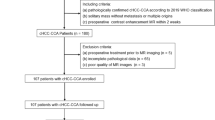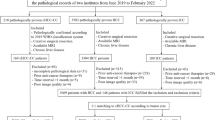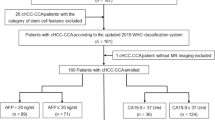Abstract
Objectives
To distinguish MR features according to different proportions of the histopathological hepatocellular carcinoma (HCC) component and to investigate whether the proportion of the HCC component can predict the prognosis of patients with cHCC-CCA.
Methods
The study enrolled 106 cHCC-CCA patients confirmed by histopathology. The MR imaging features and clinicopathological findings were retrospectively evaluated and compared between two subgroups with different proportions of the HCC component. The recurrence-free survival (RFS) and overall survival (OS) were evaluated using Kaplan–Meier survival curves and compared using the log-rank test. Moreover, whether the proportion of the HCC component was a predictor of RFS and OS was investigated using Cox regression analyses.
Results
The Liver Imaging Reporting and Data System (LI-RADS) category 4/5 was more prevalent in cHCC-CCAs with an HCC component > 50% (odds ratio (OR) = 5.559, p = 0.018), 70% (OR = 4.031, p = 0.008), and 90% (OR = 6.282, p = 0.012) than in those with an HCC component ≤ 50%, 70%, and 90%, respectively. In addition, cHCC-CCAs with an HCC component > 70% (HR: 0.241, p = 0.023) had a better OS prognosis than those with an HCC component ≤ 70%.
Conclusions
cHCC-CCAs categorized as LR-4/5 are mainly composed of HCC component, and cHCC-CCAs with an HCC component > 70% are associated with better OS than those with an HCC component ≤ 70%. These findings suggest that the proportion of HCC or CCA component can predict the prognosis of cHCC-CCA patients.
Key Points
• cHCC-CCAs categorized as LR-4/5 are mainly composed of HCC component.
• cHCC-CCAs with an HCC component > 70% are associated with better OS than those with an HCC component ≤ 70%.




Similar content being viewed by others
Abbreviations
- AFP:
-
Alpha fetoprotein
- APHE:
-
Arterial phase hyperenhancement
- CA19-9:
-
Carbohydrate antigen 19-9
- cHCC-CCA:
-
Combined hepatocellular carcinoma and cholangiocarcinoma
- HBV :
-
Hepatitis B virus
- HCC :
-
Hepatocellular carcinoma
- iCCA :
-
Intrahepatic cholangiocarcinoma
- LR :
-
LI-RADS = Liver Imaging Reporting and Data System
- MVI :
-
Microvascular invasion
- OS :
-
Overall survival
- RFS :
-
Recurrence-free survival
References
Sciarra A, Park YN, Sempoux C (2020) Updates in the diagnosis of combined hepatocellular-cholangiocarcinoma. Hum Pathol 96:48–55
Garancini M, Goffredo P, Pagni F et al (2014) Combined hepatocellular-cholangiocarcinoma: a population-level analysis of an uncommon primary liver tumor. Liver Transpl 20:952–959
Sempoux C, Kakar S, Kondo F, Schirmacher P (2019) Combined hepatocellular-cholangiocarcinoma. In: Bosman FT, Carneiro F, Hruban RH, Theise ND (eds) WHO classification of tumours: digestive system tumours, vol 2019, 5th edn. IARC, Lyon, pp 260–262
Nagtegaal ID, Odze RD, Klimstra D et al (2020) The 2019 WHO classification of tumours of the digestive system. Histopathology 76:182–188
Zhou CW, Wang Y, Ma L, Qian XL, Yang C, Zeng MS (2022) Combined hepatocellular carcinoma-cholangiocarcinoma: MRI features correlated with tumor biomarkers and prognosis. Eur Radiol 32:78–88
Gera S, Ettel M, Acosta-Gonzalez G, Xu R (2017) Clinical features, histology, and histogenesis of combined hepatocellular-cholangiocarcinoma. World J Hepatol 9:300–309
Shetty AS, Fowler KJ, Brunt EM, Agarwal S, Narra VR, Menias CO (2014) Combined hepatocellular-cholangiocarcinoma: what the radiologist needs to know about biphenotypic liver carcinoma. Abdom Imaging 39:310–322
Yin X, Zhang BH, Qiu SJ et al (2012) Combined hepatocellular carcinoma and cholangiocarcinoma: clinical features, treatment modalities, and prognosis. Ann Surg Oncol 19:2869–2876
Chok KSH, Ng KKC, Cheung TT et al (2009) An update on long-term outcome of curative hepatic resection for hepatocholangiocarcinoma. World J Surg 33:1916–1921
Jarnagin WR, Weber S, Tickoo SK et al (2002) Combined hepatocellular and cholangiocarcinoma: demographic, clinical, and prognostic factors. Cancer 94:2040–2046
Jiang XX, Huang XT, Huang CS, Chen LH, Liang LJ, Yin XY (2020) Long-term outcome and prognostic factors of combined hepatocellular carcinoma and cholangiocarcinoma after curative resection. Gastroenterol Rep 8:134–142
Wang XL, Wang WT, Ma XJ et al (2020) Combined hepatocellular-cholangiocarcinoma: which preoperative clinical data and conventional MRI characteristics have value for the prediction of microvascular invasion and clinical significance? Eur Radiol 30:5337–5347
Zhou CW, Ni XY, Lu X et al (2021) MR features based on LI-RADS ver. 2018 correlated with cytokeratin 19 expression in combined hepatocellular carcinoma-cholangiocarcinoma. J Hepatocell Carcinoma 8:975–983
Choi SH, Lee SS, Park SH et al (2019) LI-RADS classification and prognosis of primary liver cancers at gadoxetic acid-enhanced MRI. Radiology 290:388–397
Choi SH, Jeon SK, Lee SS et al (2021) Radio-pathologic correlation of biphenotypic primary liver cancer (combined hepatocellular cholangiocarcinoma): changes in the 2019 WHO classification and impact on LI-RADS classification at liver MRI. Eur Radiol 31:9479–9488
Stavraka C, Rush H, Ross P (2019) Combined hepatocellular cholangiocarcinoma (cHCC-CC): an update of genetics, molecular biology, and therapeutic interventions. J Hepatocell Carcinoma 6:11–21
Maximin S, Ganeshan DM, Shanbhogue AK et al (2014) Current update on combined hepatocellular-cholangiocarcinoma. Eur J Radiol Open 1:40–48
Mazzaferro V, Llovet JM, Miceli R et al (2009) Predicting survival after liver transplantation in patients with hepatocellular carcinoma beyond the Milan criteria: a retrospective, exploratory analysis. Lancet Oncol 10:35–43
Jeon SK, Joo I, Lee DH et al (2019) Combined hepatocellular cholangiocarcinoma: LI-RADS v2017 categorisation for differential diagnosis and prognostication on gadoxetic acid-enhanced MR imaging. Eur Radiol 29:373–382
He C, Mao Y, Wang J et al (2018) The predictive value of staging systems and inflammation scores for patients with combined hepatocellular cholangiocarcinoma after surgical resection: a retrospective study. J Gastrointest Surg 22:1239–1250
Park SH, Lee SS, Yu E et al (2017) Combined hepatocellular-cholangiocarcinoma: gadoxetic acid-enhanced MRI findings correlated with pathologic features and prognosis. J Magn Reson Imaging 46:267–280
Funding
This study was supported by Clinical Research Plan of SHDC (grant number SHDC2020CR1029B), National Natural Science Foundation of China (grant number 82171897), Shanghai Municipal Key Clinical Specialty (grant number shslczdzk03202), and Clinical Research Project of Zhongshan Hospital, Fudan University (grant number 2020ZSLC61).
Author information
Authors and Affiliations
Corresponding authors
Ethics declarations
Guarantor
The scientific guarantor of this publication is Mengsu Zeng.
Conflict of interest
The authors of this manuscript declare no relationships with any companies whose products or services may be related to the subject matter of the article.
Statistics and biometry
Two of the authors (Changwu Zhou and Xin Lu) have significant statistical expertise.
Informed consent
Written informed consent was obtained from all patients in this study.
Ethical approval
Institutional Review Board approval was obtained.
Study subjects or cohorts overlap
Some study subjects or cohorts have been previously reported in a prior study entitled “MRI features predict the prognosis of combined hepatocellular carcinoma and cholangiocarcinoma after curative resection” on the publication of European Radiology.
Methodology
• retrospective
• observational
• performed at one institution
Additional information
Publisher’s note
Springer Nature remains neutral with regard to jurisdictional claims in published maps and institutional affiliations.
Supplementary Information
ESM 1
(DOCX 85 kb)
Rights and permissions
Springer Nature or its licensor holds exclusive rights to this article under a publishing agreement with the author(s) or other rightsholder(s); author self-archiving of the accepted manuscript version of this article is solely governed by the terms of such publishing agreement and applicable law.
About this article
Cite this article
Zhou, C., Lu, X., Wang, Y. et al. Histopathological components correlated with MRI features and prognosis in combined hepatocellular carcinoma-cholangiocarcinoma. Eur Radiol 32, 6702–6711 (2022). https://doi.org/10.1007/s00330-022-09065-y
Received:
Revised:
Accepted:
Published:
Issue Date:
DOI: https://doi.org/10.1007/s00330-022-09065-y




